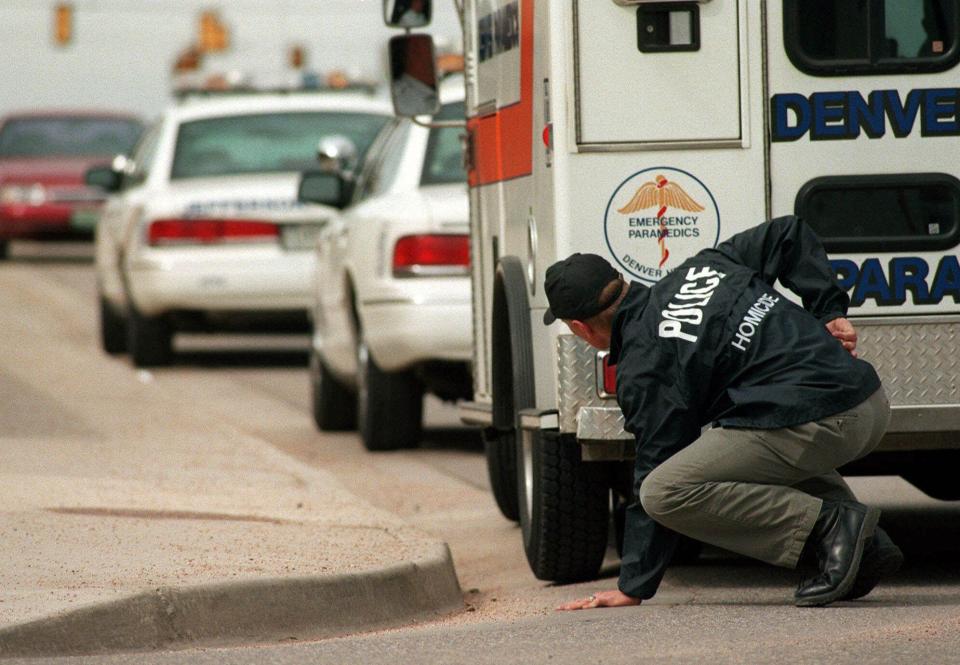Columbine tragedy 20 years later: Despite fears, risk of dying in school shooting is low

Saturday marks the 20th anniversary of Columbine High School massacre in which a dozen students and one teacher were killed during a coldly-calculated assault with high-powered firearms. The images of the horrific event, broadcast live via satellite trucks and captured on the school’s surveillance tapes, have remained fresh in the minds of Americans even after so many years. The anniversary is not only an occasion for remembering the victims, but for contemplating Columbine’s legacy.
There have been other school shootings with staggering body counts. But none has had quite the same impact on our collective consciousness nor such a prominent place in popular culture.
The hour-long killing spree has been chronicled in countless books, spawned movies of various genres, and is tastelessly recalled through tee-shirts, action figures and a role-play video game. It has also inspired copycats.
A particularly troubling legacy lies in boundless fear of school shootings. A cohort of youngsters — students forced repeatedly to participate in so-called "Columbine Drills" — have labeled themselves the Columbine Generation for their ever-present concern for surviving school.

Read more commentary:
Parkland victim's father: Traumatized students shouldn't have been flung into politics
Media amplifies New Zealand shooting suspect's 'manifesto,' giving mass killers a platform
I moved my kids from Florida to New Zealand, only to need to explain mass shootings anyway
Not to disregard the significant impact of any school shooting, the level of fear is inconsistent with the risk. In the 19 academic years since Columbine, a total of 124 students have been fatally shot at school, for an average of five annually. By contrast, over that same time frame 20,000 school-age youngsters have been the victims of gun homicide — 1,500 of them at the hands of a family member. By providing supervision and structure, our nation’s schools are safe; for some children, safer even than their own homes.
Elevating fear instead of alleviating it
Despite the statistical rarity, obsessing over the risk and frequent reminders that a Columbine-style shooting could happen anywhere do more to elevate fear than alleviate it. Surrounding students with a fortress-like environment sends a strong message of imminent threat: The bad guy is gunning for you!
In contrast to metal detectors and active shooter drills, students can be protected through unobtrusive measures, including the installation of bullet-resistant glass and tiny acoustic sensors that would immediately alert the police to the location of gunfire. Moreover, schools can be designed or reconfigured to limit unwelcome access and the resulting carnage should an armed assailant seek to turn a school into a personal battleground.
Partly inspired by lessons learned at Columbine, the “Run, Hide, Fight” tactic has been promoted as a “best practice” by Homeland Security. Unfortunately, much of the emphasis has been on the last resort of engaging the assailant in a counterattack. Schools have increased the deployment of school resource officers, teachers with concealed weapons, and even provided students with rocks and hockey pucks to repel a gunman.
Meanwhile, less attention has been given to the higher priority options of run and hide. For example, hallways that are well-illuminated and free of obstacles, such as recycle bins and display tables, improve avenues for escape. Less obvious are appropriate strategies for providing adequate safe cover.
Protection isn't just new locks
By calibrating levels of visibility, Linda Nubani and Kristy Kellom of the School of Planning, Design and Construction at Michigan State University are researching the optimal mix of open spaces and hiding places. Expansive atriums and the abundance of glass walls, although pleasant aesthetically, have been shown to make people feel exposed and vulnerable. Such designs can also hinder the ability of first responders to approach an active shooter with adequate cover. On the other hand, school personnel need unobstructed sight lines to keep watch for any threatening individuals, be they students or intruders.
Classroom design features are similarly critical in shielding students. For the sake of energy efficiency, some rooms are equipped with motion-activated lights, hardly ideal if students need to hide from a gunman stalking the halls. The increased use of inside door locks, believed to deter an active shooter, can create other hazards. Not only can an unattended classroom with a lockable door offer an opportunity for sexual assault, the more complicated locking systems can interfere with flight attempts especially when thinking and physical dexterity are compromised under extreme stress.
Of course, protecting students is about more than just creating safe places. It also requires investing in supportive programming and people — especially teachers and counselors who can help divert a troubled youngster from a path towards something worse. That would be the best legacy of Columbine.
James Alan Fox is the Lipman Professor of Criminology, Law and Public Policy and member of the USA TODAY Board of Contributors. Kristy Kellom is an instructor of interior design at Michigan State University. Follow James on Twitter: @jamesalanfox
You can read diverse opinions from our Board of Contributors and other writers on the Opinion front page, on Twitter @usatodayopinion and in our daily Opinion newsletter. To respond to a column, submit a comment to letters@usatoday.com.
This article originally appeared on USA TODAY: Columbine tragedy 20 years later: Despite fears, risk of dying in school shooting is low

